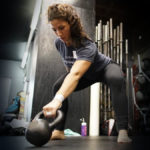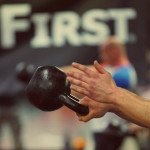“You’ve fallen victim to one of the classic blunders…”—Vizzini, Princess Bride
Sorry, I couldn’t help myself. This article is about a common error in the kettlebell swing, and we should never accuse a student of a blunder, but come on—you’ve got to admit that’s funny.
So, moving on.
One of the common errors we see in the kettlebell swing is the student leaning back or having lumbar extension at the top of the swing instead of finding the “standing plank” at the top/finish of the swing.
This is usually caused by a couple of different things:
- Pulling up with the shoulders instead of driving the force into the ground.
- Putting extra effort into finishing the swing.
I have discussed the “perfect swing” and other swing blunders (there’s that word again) in other articles. For this article, I want to introduce you to a self-correcting drill to address having too much extension at the top of the kettlebell swing.
The “Fingers” to the Back Drill
At the SFG Certification, we call it the “fingers to the back drill,” but you can apply this at your home or gym by using a stretch band of some sort (in the video, I am using a Jump Stretch band stretched around a squat/pull-up stand). You can also tape the band to the sides of a door-frame and get the same effect.
How to do the drill:
- Stretch the band across the power rack (or whatever) at the level of your mid back/mid shoulder blades.
- Stand as if you are at the top of a perfect swing at a distance from the band where you can barely feel it.
- Step forward about two inches.
- Perform a set of swings.
- If you hit the band with your back at the top of a swing, then it’s likely you overextended.
Note: If you set yourself up too close to the band, it will restrict you too much. Conversely, if you step too far away, the band won’t provide any feedback, so pay attention to detail in steps two and three of the instructions.
Other mental images to accompany the feedback of the band:
- Drive your feet and force into the ground instead of pulling up with the shoulders. Imagine you are leaving one-inch deep footprints.
- Find the standing plank at the top of the swing and finish tall. If you are 5 foot 9 inches tall, then be 5 foot 9 inches tall at the finish, too.
- Take your time and dial back the effort of the swing. Note: I did not say slow down, but rather turn the volume down a bit on your effort.
Try This Drill and See What You Learn
Even if you don’t think you are leaning back at the top of the kettlebell swing still give this drill a try. Remember that full extension at the top of the swing is done through the hips to reach a “standing plank,” not by leaning back into lumbar extension.
Happy swinging!








I think this article is useful for reducing injuries in less experienced lifters whether they use the drill described or no: this advice was more nicely designed than many of the articles here and delightfully simplistic to foster understanding all the better
Wow, excellent idea
If the weight is big enough then I guess it is ok to lean back a bit, but fron the ancles, am I right ?
Yes – once the weight is heavy enough there will be a “projection” backward as a counterbalance and it does come from the ankles not the extending of the lower back.
Great Tip!
Love this drill!!!